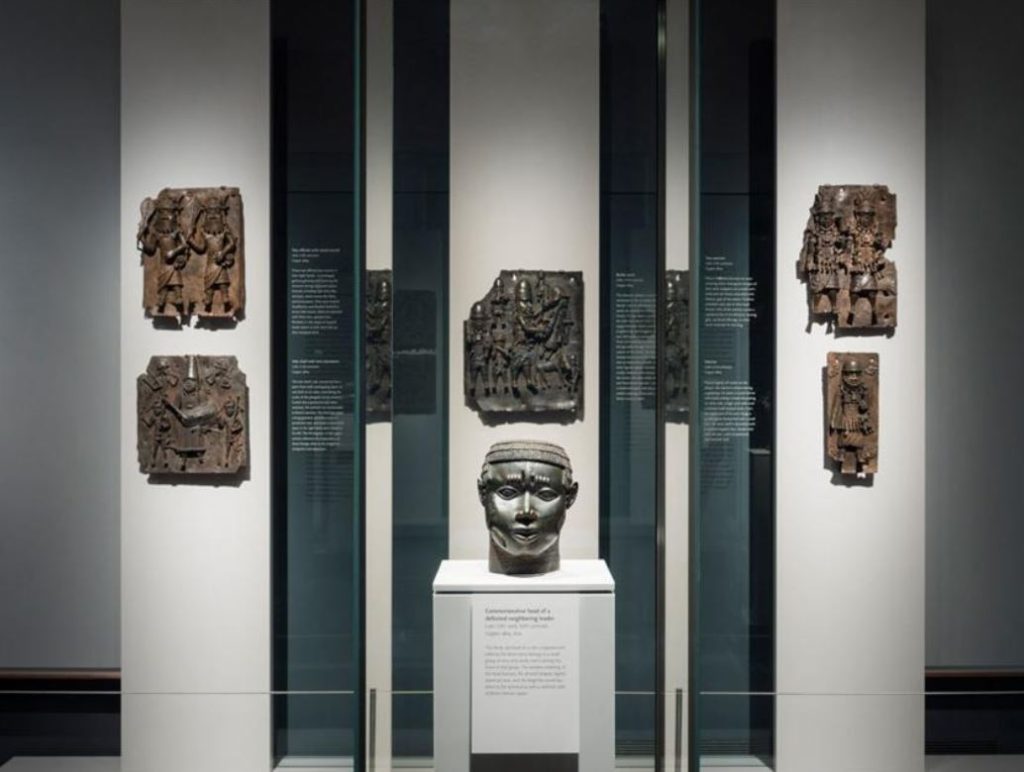
បេនិន(Benin) គឺជាឈ្មោះនៃអរិយធម៌ និងជាអាណាចក្រដ៏មានឥទ្ឋិពលមួយនៅក្នុងតំបន់អាហ្រ្វិចខាងលិច ហើយសព្វថ្ងៃ គឺជាប្រទេសនីហ្សេរីយ៉ា( Nigeria)។ ប្រវត្តិសាស្រ្តនៃអរិយធម៌នេះ គឺកើតឡើងចេញពីក្រុមជនជាតិមួយក្រុមដែលហៅថា អ៊ីដូ(Edo) ដែលរស់នៅខាងត្បូងនៃប្រទេសនីហ្សេរីយ៉ា(រូបលេខ១)។
បេនិនបានក្លាយជាអាណាចក្រនៅស.វ.ទី១០នៃគ.ស. និងនៅស.វ.ទី១៥បានក្លាយជាអាណាចក្រដ៏មានអំណាចមួយនៅក្នុងតំបន់អាហ្វ្រិចខាងលិច ដោយ អូបា អ៊ីវៀ (Oba Ewuare)។ ចំពោះពាក្យ អូបា(Oba)ក្នុងប្រវត្តិសាស្រ្តនៃបេនិន មានន័យថាជា«ស្តេច»។ នៅក្នុងការគ្រប់គ្រងដោយ អូបា អ៊ីវៀ បានពង្រីក ទឹកដី និងអភិវឌ្ឍន៍ហេដ្ឋារចនាសម្ព័ន្ធនៅក្នុងរាជធានី ដែលសព្វថ្ងៃជាទីក្រុងបេនិន (Benin City) ឬហៅថា រដ្ឋអ៊ីដូ (Edo state) ដែលស្ថិតនៅខាងត្បូងនៃប្រទេសនីហ្សេរីយ៉ា។

ទីក្រុងបេនិន ស្ថិតនៅខាងត្បូងនៃប្រទេសនីហ្សេរីយ៉ា និងមានចម្ងាយប្រមាណ ៣៦០គីឡូពីរាជធានី អាប៊ូចា (Abuja)។ រចនាសម្ព័ន្ធដែលសំខាន់ជាងគេនៅក្នុងទីក្រុងបេនិន គឺជាកំពែងដីមានកម្ពស់ជាង១៨ម៉ែត្រ និងមានបណ្តាយប្រមាណ ១២០០គីឡូម៉ែត្រ ដែលព័ទ្ធជុំវិញទីក្រុងនេះ ប៉ុន្តែកំពែងនេះត្រូវបានបំផ្លាញដោយ អង់គ្លេស អំឡុងពេលដែលដាក់អាណានិគមលើប្រទេសនីហ្សេរីយ៉ា ក្នុងស.វ.ទី១៩។ ចាប់ពីឆ្នាំ២០០២រហូតដល់២០០៦ គម្រោងមូលនិធិសំណង់ពិភពលោកបានមកជួសជុលសំណល់កំពែងដីនោះ។
វត្ថុសិល្បៈ នៃអរិយធម៌នេះជាច្រើនត្រូវបានទាហានអង់គ្លេសយកចេញពីប្រទេស នីហ្សេរីយ៉ា ទៅកាន់តំបន់អ៊ីរ៉ុប។ នៅក្នុងឆ្នាំ ២០១២, លោក Robert Owen Lehman បានប្រគល់វត្ថុសិល្បៈជាច្រើននៃអរិយធម៌បេនិនដល់សាមន្ទីរសិល្បៈបូស្តុង (Museum of Fine Arts, Boston) ដែលមានចំនួនសរុប៣៤វត្ថុ។ តាមរយៈវត្ថុសិល្បៈទាំងនោះបានបង្ហាញឱ្យឃើញអំពីទំនៀមទំលាប់វប្បធម៌ របស់មនុស្សក្នុងអរិយធម៌នេះ។ គួរបញ្ជាក់ដែរថា Robert Owen Lehman គឺជាអ្នកប្រមូលរក្សាទុកវត្ថុសិល្បៈក្នុងតំបន់អាហ្រ្វិចដ៏ល្បីល្បាញម្នាក់ចាប់ពីទ.វ.ទី៨០មកម្ល៉េះ។ វត្ថុសិល្បៈទាំងនោះ គឺស្ថិតក្នុងសភាពល្អស្អាតដែលភាគច្រើនធ្វើអំពីសំរិទ្ធ។ ប្រហែល៣៥០០វត្ថុសិល្បៈនៃអរិយធម៌បេនិនដែលផលិតអំពីស្ពាន់ និងអំពីភ្លុកសត្វ ដែលត្រូវបានរក្សាទុកនៅក្នុងបណ្តាសារមន្ទីរបរទេសនៅអីរ៉ុបនិង អាមេរិក ជាដើមក្នុងនោះរួមមាននៅសារមន្ទីរចក្រភពអង់គ្លេស (The British Museum) , ប៊ែកឡាំង, វេណា(Weltmuseum Vienna), ញូវយ៉ក (The Metropolitan Museum of Art) និងនៅឡាហ្គោសជាដើម។


(ប្រភព៖ https://www.mfa.org/news/benin-kingdom)
មនុស្សក្នុងអរិយធម៌នេះមានជំនាញក្នុងការផលិតវត្ថុសិល្បៈ តាមទម្រង់ប្លែក តែមានបច្ចេកទេសខ្ពស់ ដែលភាគច្រើនផលិតអំពីលោហៈធាតុ ដូចជាសំរិទ្ធ និងប្រាក់ជាដើម។ តាមរយៈវត្ថុសិល្បៈទាំងនោះ អាចបង្ហាញថា អរិយធម៌បេនិន គឺពូកែខាងលោហៈកម្ម ដែលខ្ញុំធ្លាប់បានបង្ហាញកាលពីអត្ថបទមុនៗរួមមកហើយ ដោយអរិយធម៌នៅក្នុងទ្វីបអាហ្វ្រិចភាគច្រើនគឺជំនាញខាងផ្នែកផលិតលោហៈធាតុដូចជា បច្ចេកទេសចម្រាញ់ដែកពីរ៉ែ និងបច្ចេកទេសស្មិតលោហធាតុឱ្យទៅជាវត្ថុសិល្បៈផ្សេងៗ ដែលបញ្ជាដោយស្តេច ឬមន្រី្តដែលទម្រង់ទាំងនោះ គឺស្របទៅនឹងសង្គមរបស់ពួកគេ។ វត្ថុសិល្បៈបុរាណក្នុងអរិយធម៌បេនិនភាគច្រើនគឺធ្វើឡើង ដើម្បីឧទ្ទេស និងគោរពដល់អូបា (ស្តេច) នៃអាណាចក្របេនិន។


អាណាចក្របេនិនត្រូវដូលរលំ និងបញ្ចប់នៅស.វ.ទី១៩ ដោយសារការឈ្លានពាន និងដាក់អាណានិគមពីសំណាក់ចក្រភពអង់គ្លេស។
សរុបមក អរិយធម៌ និងអាណាចក្រមានអាយុកាល៩ស.វ និងជាអរិយធម៌ដែលមានអំណាចក្នុងចំណោមអរិយធម៌ក្នុងតំបន់អាហ្រ្វិចខាងលិច។ ទិន្ន័យទាំងអស់នេះ គឺបង្ហាញតាមរយៈការសិក្សាលើវត្ថុសិល្បៈដែលសេសសល់ និងវត្ថុសិល្បៈរក្សាទុកនៅបណ្តាសារមន្ទីរបរទេស ដែលបានបង្ហាញពីខាងលើ៕
———————————–
Benin Civilization
Benin is the name of civilization and an influential empire in West Africa and today Nigeria. The history of this civilization comes from a group of people called Edo who live in southern Nigeria.
Benin became an empire in the 10th century and in the 15th century, Oba Ewuare became a powerful empire in West Africa. The word Oba in the history of Benin means “king”. Under Oba Ewuare administration, it expanded its territory and developed infrastructure in the capital, now Benin City, or called Edo state in southern Nigeria.
Benin is in the south of Nigeria, about 360 km from the capital Abuja. The most important structure in Benin was a wall more than 18 meters high and about 1,200 kilometers around the city, but it was destroyed by the British during the colonization of Nigeria in the 19th century. From 2002 to 2006, the World Monument Fund project came to reconstruct the remains of the wall.
Many artifacts of this civilization were taken by British troops from Nigeria to Europe. In 2012, Robert Owen Lehman donated a total of 34 objects of the Benin civilization to the Museum of Fine Arts, Boston. Through these artifacts, the cultural traditions of the people in this civilization are revealed. It should be noted that Robert Owen Lehman is a famous collector of art in Africa since the 80s. The artifacts are in good condition, mostly made of bronze. About 3,500 artifacts of the Benin civilization, made of copper and ivory, are conserved in foreign museums in Europe and the United States, including at The British Museum, Berlin, Vienna (Weltmuseum Vienna), New York (The Metropolitan Museum of Art), and in Lagos.
The kingdom of Benin collapsed and end in the 19th century due to British invasions and colonization.
In conclusion, the civilization and empire have only ninth century and were one of the most powerful civilizations in West Africa. All this data is presented through the study of the remaining artifacts and artifacts kept in the foreign museums shown above.
អត្ថបទដើម៖ លោក អេង តុលា






